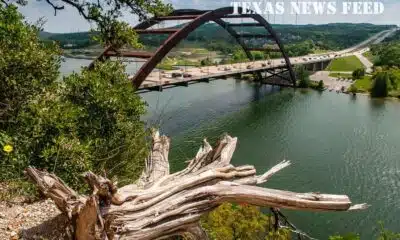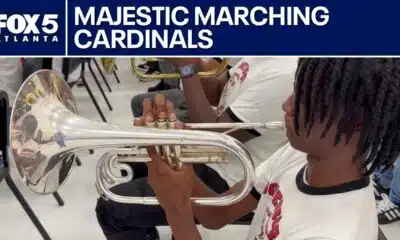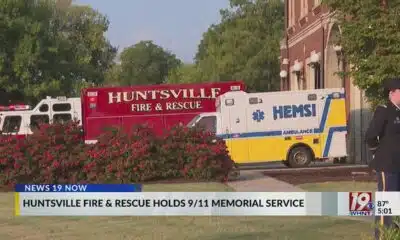News from the South - North Carolina News Feed
What is UNC Asheville doing on wooded property near Five Points? Taxi ‘shed’ at Asheville Regional Airport? What does ‘titled debris’ actually mean? • Asheville Watchdog
Today’s round of questions, my smart-aleck replies and the real answers:
Question: For years, UNCA has owned land off Dortch Avenue known as the South Campus walking trails that include about one mile of wooded hiking paths. Many residents (especially those of us with four-legged family members) of Five Points and nearby neighborhoods love the woods for the opportunity they provide for connection to nature and dog frolicking (we’re not opposed to cat- or small horse-frolicking, but dogs seem to be the more popular four-legged companion). The woods are a bit of a hidden gem, and they’ve been even more of a refuge with so many dog parks closed after Helene. In the last few weeks, we’ve noticed caution tape, survey stakes, and wetland tape in various places, and a tree removal crew has begun clearing some brush at the entrance. One of the workers informed us that the university is developing the land and plans to construct four buildings; work will apparently start in the spring. There hasn’t been any signage in the woods and we haven’t been able to learn any details from the university. Any chance you can help investigate? We’d love to know if the development rumors are true, if the university is developing or if they’ve sold the land, the timeline, how the project is actually being funded given the university’s financial situation, and what the building and space will be used for.
My answer: Every time I see a cat out for a “frolic” on a leash, it looks like the poor animal is absolutely miserable and would probably take out its owner if it weighed 30 pounds more.
Real answer: UNC-Asheville spokesman Brian Hart said no decisions have been made on the property.
“UNC Asheville is taking steps to better understand the characteristics of 90 acres of undeveloped portions of university property,” Hart said via email. “This includes assessing boundaries, topography, land composition, and utilities. To support this process, the university has authorized an experienced external vendor to conduct a thorough exploratory assessment, which will require removing a minimal number of trees and collecting soil samples.”
Hart said the university is dedicated to working with environmental experts about sustainable and responsible land use.
“In keeping with our commitment to transparency and collaboration, as options are being finalized, UNC Asheville will host listening sessions to share information about potential plans and to gather input from the community,” Hart said.
Hart said “exploring thoughtful and strategic opportunities for land use is part of the university’s efforts to have a positive impact here.”
“Any future development of university property will align with the best interests of the institution, the local and regional community, and the state of North Carolina, while respecting the natural environment that surrounds us,” Hart said.
The City of Asheville said it has not issued any permits for the current work, and that the permit for the work was issued through the North Carolina Department of Environmental Quality.
The DEQ did not respond to my request for information by deadline.

Question: We are an older couple (even older than John) who returned home recently, flying into AVL airport. After landing, we went to the info desk by baggage claim to inquire as to taxis to get to our home in Asheville. We were told there were no taxis, and we’d have to wait in an outer lot until an Uber or Lyft could pick us up. The only alternative presented to us was a black car service (probably $150). There was a shuttle bus waiting by chance, and we proceeded to the “shed” to wait. The wind was blowing strongly right through the shed, as there was no protection from the sides from the freezing cold (wind chill of 18) and it was located in an open parking lot. Luckily for us, an Uber was available in five minutes; a Lyft would have been at least 20 minutes — enough time for frostbite to set in! This is an unacceptable situation for us and certainly for visitors to Asheville. If the airport is going to abandon those waiting for rides to a lonely parking lot, they can at least provide a better shelter with sides and a heater, as well as some sort of emergency notification system if there is a problem. Even as a temporary fix, this is unacceptable, as a medical emergency is certainly possible in the shed. Our Uber driver told us he has seen instances where the rain is blowing through the shed sideways on those waiting. When will the airport provide an acceptable waiting area for those arriving at the airport?
My answer: I’m going to politely overlook the comment about these folks being “even older” than I am. Clearly it’s time for me to up my “Just for Men” beard dye game.
Real answer: Good news on this front.
“We have installed a 12- by 15-foot covered shelter in the ground transportation pick-up area, with four benches and standing room for additional customers,” Asheville Regional Airport spokeswoman Tina Kinsey said via email, adding that it is a temporary location due to construction at the airport. “We have wind/rain barriers for the sides of the shelter coming soon, as well as additional lighting inside. The pick-up area is lighted with exterior lights, and we have an emergency call box in place for our customers.”

Question: I just finished your recent column about debris removal and was fascinated by the concept of “titled” debris. I never thought about the implications of that before. Could you expand on whether and what kind of special problems and handling that causes? For example, if there’s a car in the river, does the county have to figure out who owns it, contact them, consult on what they want done with it, whether they’ll pay for or toward the removal, whether their insurance has any liability in the effort and so forth? Can the county just act without contacting the owner at all? Is there any kind of time limit beyond which the county can do what it needs to do to clear its waterways if they can’t contact an owner?
My answer: Initially, I just assumed “titled debris” meant the county was going to have to refer to river debris as “Sir Wrecked Minivan” and “Lady Semi Trailer.”
Real answer: Nothing is simple when it comes to Helene cleanup.
“County departments, to include the Buncombe County Sheriff’s Office, County Legal Department, Solid Waste, ID Bureau, and Emergency Management are working together on title property removal,” Johanna Cano, a spokeswoman for Buncombe County, told me via email. “There are a couple of different categories of title property removal that include right of way removal, right of entry (private property), and waterway removal.”
The different categories require different types of administrative paperwork for accessing the debris.
“While we are close to finalizing the process, at this point, as title property is identified and mapped out, crews will be going around to assess the property for identification such as a vehicle identification number or tag,” Cano said. “The team will work across departments to locate the owner and make arrangements for removal. As owners are identified, they will need to check with their insurance company to determine if their coverage can pay for towing, etc.”
If not, the county will use a towing company procured through a “request for proposals” to “remove the property and take it to a processing site where it can be claimed or otherwise processed,” Cano said.
Asheville Watchdog is a nonprofit news team producing stories that matter to Asheville and Buncombe County. Got a question? Send it to John Boyle at jboyle@avlwatchdog.org or 828-337-0941. His Answer Man columns appear each Tuesday and Friday. The Watchdog’s reporting is made possible by donations from the community. To show your support for this vital public service go to avlwatchdog.org/support-our-publication/
Related
The post What is UNC Asheville doing on wooded property near Five Points? Taxi ‘shed’ at Asheville Regional Airport? What does ‘titled debris’ actually mean? • Asheville Watchdog appeared first on avlwatchdog.org
News from the South - North Carolina News Feed
White House officials hold prayer vigil for Charlie Kirk
SUMMARY: Republican lawmakers, conservative leaders, and Trump administration officials held a prayer vigil and memorial at the Kennedy Center honoring slain activist Charlie Kirk, founder of Turning Point USA. Kirk was killed in Utah, where memorials continue at Utah Valley University and Turning Point USA’s headquarters. Police say 22-year-old Tyler Robinson turned himself in but has not confessed or cooperated. Robinson’s roommate, his boyfriend who is transitioning, is cooperating with authorities. Investigators are examining messages Robinson allegedly sent on Discord joking about the shooting. Robinson faces charges including aggravated murder, obstruction of justice, and felony firearm discharge.
White House officials and Republican lawmakers gathered at the Kennedy Center at 6 p.m. to hold a prayer vigil in remembrance of conservative activist Charlie Kirk.
https://abc11.com/us-world/
Download: https://abc11.com/apps/
Like us on Facebook: https://www.facebook.com/ABC11/
Instagram: https://www.instagram.com/abc11_wtvd/
Threads: https://www.threads.net/@abc11_wtvd
TIKTOK: https://www.tiktok.com/@abc11_eyewitnessnews
News from the South - North Carolina News Feed
Family, friends hold candlelight vigil in honor of Giovanni Pelletier
SUMMARY: Family and friends held a candlelight vigil in Apex to honor Giovanni Pelletier, a Fuquay Varina High School graduate whose body was found last month in a Florida retention pond. Giovanni went missing while visiting family, after reportedly acting erratically and leaving his cousins’ car. Loved ones remembered his infectious smile, laughter, and loyal friendship, expressing how deeply he impacted their lives. His mother shared the family’s ongoing grief and search for answers as authorities continue investigating his death. Despite the sadness, the community’s support has provided comfort. A celebration of life mass is planned in Apex to further commemorate Giovanni’s memory.
“It’s good to know how loved someone is in their community.”
More: https://abc11.com/post/giovanni-pelletier-family-friends-hold-candlelight-vigil-honor-wake-teen-found-dead-florida/17811995/
Download: https://abc11.com/apps/
Like us on Facebook: https://www.facebook.com/ABC11/
Instagram: https://www.instagram.com/abc11_wtvd/
Threads: https://www.threads.net/@abc11_wtvd
TIKTOK: https://www.tiktok.com/@abc11_eyewitnessnews
News from the South - North Carolina News Feed
NC Courage wins 2-1 against Angel City FC
SUMMARY: The North Carolina Courage defeated Angel City FC 2-1 in Cary, ending their unbeaten streak. Monaca scored early at the 6th minute, followed by Bull City native Brianna Pinto’s goal at the 18th minute, securing a 2-0 halftime lead. Angel City intensified in the second half, scoring in the 88th minute, but the Courage held firm defensively to claim victory. Pinto expressed pride in the win, emphasizing the team’s unity and playoff ambitions. Nearly 8,000 fans attended. Coverage continues tonight at 11, alongside college football updates, including the Tar Heels vs. Richmond game live from Chapel Hill.
Saturday’s win was crucial for the Courage as the regular season starts to wind down.
https://abc11.com/post/north-carolina-courage-wins-2-1-angel-city-fc/17810234/
Download: https://abc11.com/apps/
Like us on Facebook: https://www.facebook.com/ABC11/
Instagram: https://www.instagram.com/abc11_wtvd/
Threads: https://www.threads.net/@abc11_wtvd
TIKTOK: https://www.tiktok.com/@abc11_eyewitnessnews
-
News from the South - North Carolina News Feed5 days ago
What we know about Charlie Kirk shooting suspect, how he was caught
-
Local News Video7 days ago
Introducing our WXXV Student Athlete of the Week, St. Patrick’s Parker Talley!
-
News from the South - North Carolina News Feed6 days ago
Federal hate crime charge sought in Charlotte stabbing | North Carolina
-
Local News6 days ago
Russian drone incursion in Poland prompts NATO leaders to take stock of bigger threats
-
The Center Square7 days ago
Weapon recovered as manhunt continues in Kirk assassination investigation | National
-
Our Mississippi Home4 days ago
Screech Owls – Small but Cute
-
News from the South - Arkansas News Feed5 days ago
NW Arkansas Championship expected to bring money to Rogers
-
News from the South - Alabama News Feed6 days ago
Huntsville Fire & Rescue Holds 9/11 Memorial Service | Sept. 11, 2025 | News 19 at 5 p.m.















































